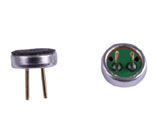
This microphone was developed to suppress disturbing ambient noise as much as possible. Only the user's speech should be transmitted loudly and clearly. This goal is achieved by the noise-canceling microphone having at least one input opening on the front and back. The diaphragm inside the microphone is attached to the center of these openings. The sound coming from the surroundings hits the diaphragm almost simultaneously through the two openings. This results in very little deflection of the diaphragm. On the other hand, sound waves from a very short distance (1-3 cm) cause a stronger deflection of the diaphragm and thus generate an electrical impulse. The reason for this is that the sound from a short distance at the front reaches the membrane sooner than the sound through the rear opening. This means that on the one hand there is no equalization, and on the other hand the sound pressure from the front dominates and thus produces a stronger signal.
